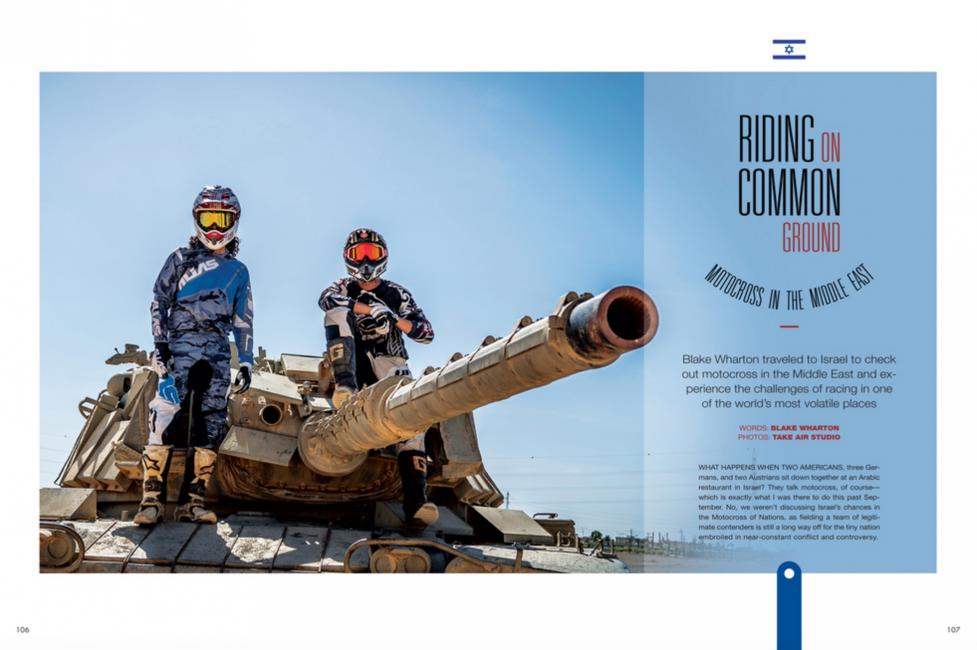You may have never heard of privateer racer Daniel Sedlak, but he’s big in Japan. And Uganda. And Indonesia, Zimbabwe, Vietnam, and many more places where they race motocross. Sedlak has raced in more than forty countries, putting on a show for the crowds while also teaching aspiring local riders the craft of motocross.
It’s a time-honored job that’s previously been filled by international travelers like MXA tester Dennis Stapleton, “Mad” Mike Jones, Asterisk’s Tom Carson, Paul Lindsey, California privateers Louie Franco and Mike Beier, our own Jason Thomas, and more. Now it’s Sedlak’s turn on that long, lucky trip where he gets paid to race dirt bikes while seeing the far corners of the world.
Racer X: Daniel, how old are you and where do you hail from originally?
Daniel Sedlak: I am 27 years old today [Tuesday] and I am originally from Germany. The last couple of years I have been lucky enough to tour the world, and when I ended up in California I decided to stay. I now live in San Diego.
Did you race pro while you were still in Germany?
Yes, I raced the German Nationals, I did some MX3 GPs, some European Championships, and some of the European supercross races.
What part of Germany are you from?
Hamburg, up north.
Back then were you watching a young Ken Roczen coming up behind you in the minicycle classes?
Absolutely! We all did. My little brother, he raced 85s with him, so they went to the European Championships together and all of that stuff. They were pretty close back then. To see Ken now, trying to be one of the best here, it’s amazing.
How did you end up traveling and racing in so many countries?
It started back in 2007 when I was invited to race in Dubai. From there I just kind of went everywhere. I went to the Philippines to race, and I met people from different Asian countries and even got invited to Vietnam last year—I’m going in January.
Do they have a lot of guys into motocross racing in Vietnam?
Compared to here or Europe it seems really, really small. Asia in general has a big motorcycling culture with everyone riding mopeds, but as far as motocross and supercross go, there’s really only a handful of guys that have the ability to race—maybe sixty or seventy guys in Vietnam that are a actually racing motocross.
Are the bikes over there modern Japanese and European bikes or are they those Chinese knock-off bikes?
You will see guys racing everything, with 2014, 2015 MX bikes, and then you will have guys on old Honda XRs, even Asian mopeds, which is only somewhat of a motocross bike. They call the racing supercross but it’s not anything like what you have here in America. The tracks are really tight, maybe just a couple of double jumps, sometimes just set up in a parking lot. It’s very different than what you have here.
Think of going to, say, Milestone today. Where would the fastest Vietnamese rider fit in, skill-wise?
That’s hard to gauge because their riding is just so different. Good local riders over there would struggle to do well in the Intermediate class here. The sport is pretty new, so there is potential for sure. They have good local riders but they would struggle here for sure. But they love motorcycles; they just haven’t had a lot of experience with motocross. I think eventually it will be really big, just like it is in Thailand and Indonesia.
When you go to a place like Vietnam or Indonesia or anywhere like that, is the moped riding on the streets—the traffic and all—just insane?
The traffic, the food, just…everything—it’s all just different, the whole culture. It’s nothing that you’re used to. But now that I have been to Asia a lot, you do get more used to it all. It’s all different, but also very interesting.
With all of the motorcycles over there—though not exactly motocross bikes—it seems like if motocross ever got a foothold, it would become pretty big in a hurry.
Yes, it would be very big in a hurry, and I think it will become very big some day. Thailand already has a really good supercross series that not many people know of, as well as a Grand Prix now. Indonesia also has its own pretty big supercross series too. And a country like China, once they really get into it, I think it will be very big over there.
We actually did a feature a few years back on the Chinese National Motocross Championship, written by an expat from Hong Kong, and it was just completely different—the bikes, the sponsors, the riding gear, the fans. It was pretty big, too, but it just seemed like a movie and not real at all.
I remember that—I read that story and it got me really interested in going to China, but there are a lot of politics involved in a lot of Asian countries. It’s like in China you can’t compete as a foreign rider, and they only have one or two races a year where they invite other guys in to race with the Chinese guys. You find that in India as well, where they kind of protect their local guys and not have many foreign riders come in.
That’s right, I remember we were trying to do a story on the greatest Indian rider ever.
Santosh! He’s like the Bubba Stewart of India. He’s huge over there.
Yes, Santosh! We’ve been trying to work on a story with him. But I saw a bunch of photos where they have these classes just for India-made bikes, and it’s like they’re riding old XRs from the seventies or something.
Yes, they do things really differently. They use their own bike brand, which is TVS, and they have a factory team that competes in their series. But yes, it’s a whole different world over there as far as what we have here.
How does it work now, going off to all of these exotic places? I mean, I was lucky enough to travel to Europe and do a few races, and it was such a cool adventure, but you really have to know the right people to get it going. Guys like you or Dennis Stapleton or Paul Lindsay and Billy Whitley back in the day, you crisscross the world racing dirt bikes. That’s a pretty cool job!
It is really cool, for sure. I got my FIM pro license in 2007 and early on I realized that I’m not good enough to make a legit living following the pro tour in Europe or here, so I set out to find a way to get paid racing my bike somewhere else. That led to the weirdest of places, like Asia, East Africa, everywhere. I’ve been to Uganda ten times this year, racing the whole African scene and just going to different races. I’m fortunate enough to be good enough on my bike to make a little bit of a living while I travel.
How much do you enjoy traveling to these new places or does it just get downright scary sometimes?
I enjoy going to scary places! I am actually trying to go to Iran here soon. At this stage I almost enjoy traveling to a place like that more than the actual racing. Some of these places are definitely places people are scared of, but I am lucky enough to have had positive experiences everywhere I’ve gone—places that seem scary on paper but when you’re actually there they are fine. Most places, motocross people are just awesome and you have a good time with them anywhere, so I try to go everywhere I can.
Uganda is probably the place where I was really surprised. They get like 20,000 people there to watch and they’re just everywhere around the track.
I saw where Iran was part of the Asian Supercross Championship or something, and then we found a photographer over there on Facebook. If you ever get to Iran, please keep us in mind for a story!
I would love to do that. I go to a lot of places and people always ask me about them, so it would be really cool to do some stories on some of these faraway places. Those trips and races are worth sharing, because you can only watch and read so many stories about the Glen Helen National. There are other places out there that have really interesting races too.
Once you started traveling and racing overseas, which race did you go to that was the furthest, most remote place—like totally off of the beaten path?
Well, in 2011 I went Malaysia and the race was out in the jungle, maybe fourteen hours drive from Kuala Lumpur. Way, way out there, truly in the middle of nowhere. I was, like, the only western-looking person there, and I was there for a whole week. That was about as far off the path as I’ve ever been, just deep in this jungle, seemingly by myself.
Which country surprised you in just how much they are into motocross?
Uganda is probably the place where I was really surprised. They get like 20,000 people there to watch and they’re just everywhere around the track. They have military security around the race and dogs and stuff to keep the people in check because they really do get into it. They have no banners—they barbwire the track to keep the people back and from interrupting the race. They throw rocks and bottles at you if you’re beating the local rider—it just all makes for a really interesting story. When I went the first time they had like thirty or forty soldiers with loaded weapons guarding the starting gate. Coming from Europe or America, that’s really intimidating, seeing active military with loaded weapons protecting your start gate.
If you can swing it to get to a race in Cuba, count me in. That’s got to be high on every traveler’s list of places to go soon.
[Laughs] Yeah, yeah, I will, but I don’t really think there’s anything going on in moto there now. But as soon as I find out and can go, I’ll let you know!
Beyond the U.S. and Europe, which part of the world has the best tracks?
Hmmm…. Well, I build tracks in Uganda, so I would say Uganda! I do like the Thai SX Series, they have really good layouts, but the dirt is not so good—it’s just too dry. And any place in southern Africa, like Zimbabwe or Zambia, they have high standards for their tracks, with pretty good watering and layouts, so I would say there.
Obviously you don’t get to take your own bikes with you, and I’m guessing there are times when you are promised one thing and you show up and it’s completely different sitting there on the bike stand. What parts do you try to take with you?
That depends. Early on I used to take a lot of stuff, but now I just bring a new chain and sprockets, because there are times where I don’t even know what bike they’ll have for me when I get there. So usually just a chain—everything else I will just try to wing it when I get there.
How many languages do you speak?
Fluently, only German and English, and a little bit of French, a little bit of others. But now I am in Uganda so much I have really learned how to communicate in their language better, or at least in pieces.
How far did you fly in 2015?
Well, I flew to Africa ten times, I did four trips to Asia.… I don’t know. It was a lot!
Do you usually go by yourself? Are you your own mechanic?
Usually they will give me a mechanic, and they often have tight travel budgets, so I am usually by myself.
Do you act as your own agent?
I do it all myself, and I actually help a couple of other guys as well, some French and Australian riders. I try to help them get to some of these races, but I do my own deals and my own sponsors and stuff.
I know you also teach some motocross schools. How do you communicate when you don’t really know the language?
That was actually the biggest thing with going to Vietnam, not really being able to talk directly to the riders because most people in countries like that don’t speak English. Fortunately, the guy who helps organize those, he’s a Cambodian who lived in America for some time, so he can come along and help me kind of translate what I said. Looking at their riding, some of it might get lost in translation, but they can watch enough that they can pick up what I am trying to show them.
I have a friend from Thailand who is a promoter, and I see him maybe once a year, usually at the Motocross of Nations. A big guy named Kraitos.…
Oh yeah, I know him. Kraitos Wongsawan. He and his dad do a lot in their country, promote supercross and road racing, and now they do the GP too. He’s a really good guy.
Kraitos is definitely the man I’m calling if I ever get to southeast Asia.
Yes, he took me to Bangkok once. That was quite a trip!

So how long do you want to keep doing this? I’m sure guys are going to be reading this thinking, Man, I’ve got to get on a program like Daniel! The chance to travel around the world to all of these crazy places and get paid to race—there are not a lot of opportunities like that. It’s a good gig.
Yes, it’s an awesome gig. But while it all sounds good, there’s a lot of work and all that goes into it, and there are a lot of countries out there that aren’t always as fun as they may sound. There’s a lot of work involved, and I traveled by myself almost all year, and it’s not always as fun as it sounds, and there are some sketchy and scary places. But for myself, I hope I can keep doing this for a few more years, at least until I find something a little more stable. I do still enjoy it and if I can get a couple more years out of it, that wouldn’t be too bad.
In the new issue we have a story written about Blake Wharton going to Israel of all places to teach a motocross school.
Yes, I know, I saw that. I was working for five years to get over there, and then the magazine shows up and he’s there! That was unfortunate for me, but that sounded like a cool story.
But whether it’s Larry Wosick going to South Africa back in the day, Tom Carson and Mike Beier racing all over Europe, or Rodney Smith going to Brazil….
Yes, I know what you mean. There are still some really cool places to race that will pay you good money to come there, especially Brazil, like Carlos Campano—he won the MX3 World Championship and then went straight to Brazil, and he’s been down there for like four or five years now. There are places out there that will still pay you to race a dirt bike. It might not be as glamorous as Anaheim 1, but it’s still money in your pocket.
And it beats selling popcorn at Anaheim 1!
Exactly. It’s a chance to keep racing and riding, and that’s a pretty good deal.







